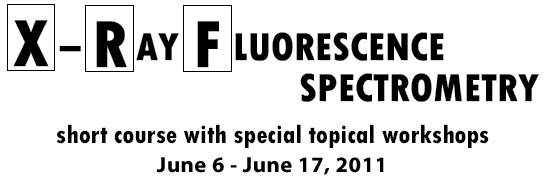
Week I - Fundamentals, Instrumentation and Qualitative Analysis
It is open to all who are working or intend to work in X-ray spectrometric analysis. No previous knowledge or background in X-ray spectrometry is required.
Topics to be covered in the lectures:
- Properties of X-rays; Origin of X-ray Spectra
- Instrumentation: Wavelength Dispersive (WD) & Energy Dispersive (ED) Spectrometers
- Dispersion of X-rays: WD Spectrometer; Collimator; Analyzing Crystals
- Detection of X-rays: Flow and Scintillation Counters; Si(Li), PIN Diode, Silicon Drift Detectors
- Pulse height Distributions and Pulse Height Selection (and ED equivalent)
- Excitation of X-rays: Characteristic Lines in Tube and Sample; Secondary Targets; Radioisotopes; Polarization
- Scattering of X-rays: Rayleigh and Compton Scattering; Sum Peak
- Matrix Effects: Absorption; Mass Absorption Coefficients
- Matrix Effects: Enhancement; Particle Size; Chemical and Mineralogical effects; Surface Effects and Infinite Thickness
- Introduction to Quantitative XRF Analysis: Basic Counting Statistics; Figure of Merits; Calibration and Corrections for Inter-element Matrix Effects.
- Selection of Instrumental Variables
plus Sample Preparation Workshop -
- Sampling and Sample Preparation (in general)
- Pressed Powder Briquettes
- Sample Preparation for Metals and Liquids
- Borate Fusion Technique
Topics to be covered in the laboratory exercises:
- Introduction to the WDXRF spectrometer
- Introduction to the EDXRF spectrometer
- Qualitative Analysis: Interpretation of Wavelength / Energy Scans
- Setting Detector Voltages; Determine Detector Resolution; Setting Pulse Height Selector
- Determination of Mass Absorption Coefficients by Transmission, Calculation from Major Element Composition and by Compton Peak Measurements
- Introduction to Quantitative XRF Analysis: Evaluation and Applications of Influence (alpha) Coefficients; Application of Mass Absorption Coefficients
Week II - Quantitative Analysis and Data Reduction Methods
A continuation from Week I. Because of the intense and demanding nature of the program, prior attendance at Week I (in this or a previous year) is usually required. In exceptional circumstances a participant may be accepted where their background and experience are considered equivalent.
Topics to be covered in the lectures:
- Introduction to Quantitative Analysis:
- Choice of Counting Positions
- Determination of Background Intensity
- Peak Deconvolution (EDXRF)
- Correction for Spectral Line Interferences
- X-ray Tube Line Interference Corrections
- Standards and Standardization
- Crystal fluorescence problems and their solutions
- Introduction to Influence Coefficients
- Mathematical Matrix Correction Techniques
- Semi-quantitative to Standardless Quantification Methods
- Quality Control and Monitors
- Summary of Advantage and Disadvantages of XRF
- Introduction of Fundamental Parameters
- Mathematical Derivation of Fundamental Parameter Method
- Fundamental Parameter Method for Bulk Sample Analysis
- Fundamental Parameter Method for Thin Film Analysis
- Fundamental Parameter Method for Multi-Layered Sample Analysis
- Monte Carlo Method for Single Layer Analysis of Irregular Shaped Sample
- Total Reflection XRF and Thin Film Analysis
- Applications
Topics to be covered in laboratory exercises:
- Major and Trace Element Data Reduction:
- Methods of Background Determination
- Correction for Peak-on-Peak and Peak-on-Background Spectral Interferences
- Determining of and Correction for X-ray Tube Line Interferences
- Iterative Cross-tail Corrections Procedures
- Standardization
- Calculation of Concentration, Counting Error and Lower Limit of Detection
- Applications of Mass Absorption Coefficients; Absorption Edge Problems; Techniques for Crossing Major Element Absorption Edges
- Calculations for Influence Coefficients; Application of Different Algorithms Correcting for Matrix Effects
Also from this web page:
Registration
XRF2011 Short Course
Sample Prep Workshop
Portable XRF Analyzer Workshop
Contact
Course Coordinator:
Charles Wu (ctwu@uwo.ca)

